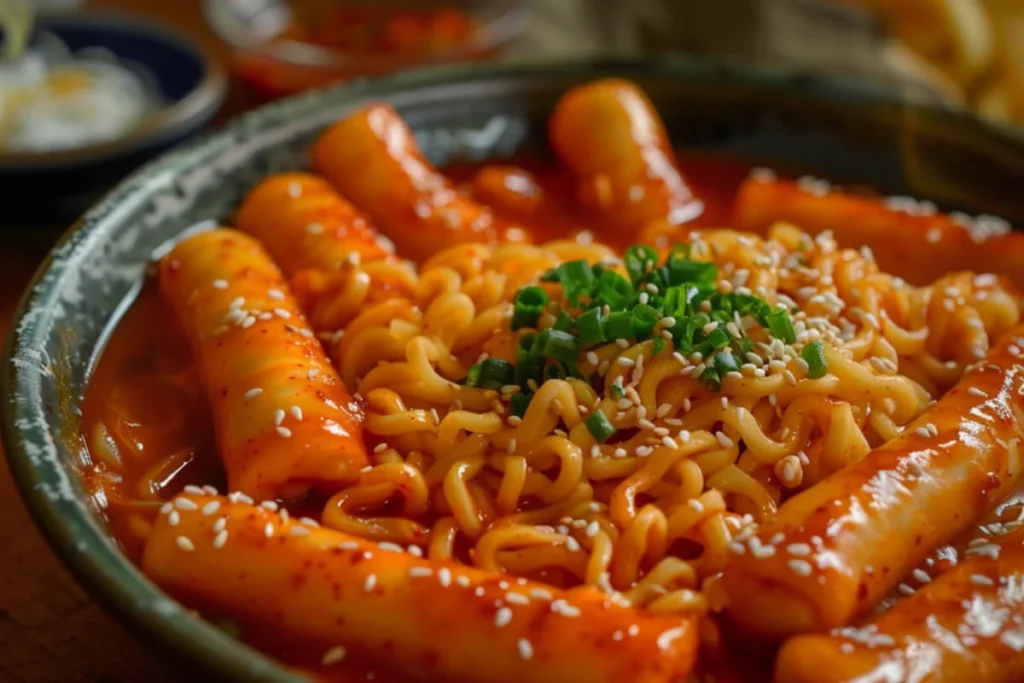
Introduction
What Makes Korean Snacks So Unique?
Korean snacks stand out for their bold flavors, creative combinations, and unique textures. From savory and spicy treats to sweet and chewy delights, Korean snacks offer a wide range of tastes that cater to all cravings. They blend traditional Korean ingredients with modern culinary twists, making them a favorite among food lovers worldwide.
Overview of the Different Types of Korean Snacks (Sweet, Savory, and Spicy)
Korean snacks can generally be categorized into three main types:
- Savory Snacks: Crunchy, salty bites like rice crackers and kimchi-flavored chips.
- Sweet Snacks: Treats like hotteok and songpyeon that combine sweetness with unique textures.
- Spicy Snacks: Popular street foods like tteokbokki that bring heat and bold flavor to every bite.
Popular Korean Savory Snacks
Kimchi Chips: Making Crispy Kimchi-Flavored Chips
Kimchi chips are a modern twist on the iconic Korean fermented cabbage. To make these at home:
- Prepare Kimchi: Use store-bought or homemade kimchi and drain excess moisture.
- Bake or Fry: Thinly slice the kimchi and bake it in an oven at 250°F until crispy, or fry lightly for added crunch.
- Season: Sprinkle with a pinch of salt or sesame seeds to enhance the flavor.
Tteokbokki (Spicy Rice Cakes): A Popular Street Food Snack
Tteokbokki is one of Korea’s most iconic street foods, known for its chewy rice cakes smothered in a spicy, sweet gochujang (chili paste) sauce.
Ingredients: Rice cakes, gochujang, sugar, soy sauce, fish cakes, and green onions.
Steps:
- Boil rice cakes until soft and chewy.
- Prepare the sauce by mixing gochujang, sugar, and soy sauce.
- Simmer the rice cakes in the sauce, adding fish cakes and vegetables for extra flavor.
Korean Sweet Snacks
Hotteok (Sweet Pancakes): A Delicious Warm Treat Filled with Brown Sugar, Cinnamon, and Walnuts
Hotteok is a popular Korean winter snack, offering a soft, chewy texture with a gooey, sweet filling.
Ingredients:
- Dough: Flour, water, yeast, sugar.
- Filling: Brown sugar, cinnamon, and chopped walnuts.
Steps to Make Hotteok:
- Prepare the dough and let it rise until fluffy.
- Roll small pieces of dough into discs and place the brown sugar mixture in the center.
- Seal and flatten the dough, then fry on a hot skillet until golden brown and crispy.
Songpyeon: Rice Cakes Filled with Sweetened Red Bean Paste
Songpyeon is a traditional Korean rice cake made during Chuseok (Korean Thanksgiving). Shaped like half-moons, these rice cakes are steamed with fragrant pine needles, infusing them with a delicate aroma.
Ingredients:
- Rice flour, water, and sweetened red bean paste or sesame seed filling.
Steps to Make Songpyeon:
- Mix rice flour with water to create a soft dough.
- Fill each piece of dough with red bean paste or a sweet sesame mixture.
- Shape into half-moons and steam on a bed of pine needles.
Korean Snack Recipes for Beginners
Easy-to-Make Korean Snacks at Home: Seaweed Snacks, Roasted Peanuts
Korean snacks don’t have to be complicated, and some of the easiest ones to make at home include:
- Seaweed Snacks (Gim): Lightly brush sheets of nori with sesame oil and sprinkle with salt. Toast them in the oven for 5–10 minutes at 300°F until crisp.
- Roasted Peanuts: Toss peanuts with a bit of sesame oil, sugar, and salt, then roast them in the oven for 10–12 minutes until golden. These simple snacks are quick to prepare and full of flavor.
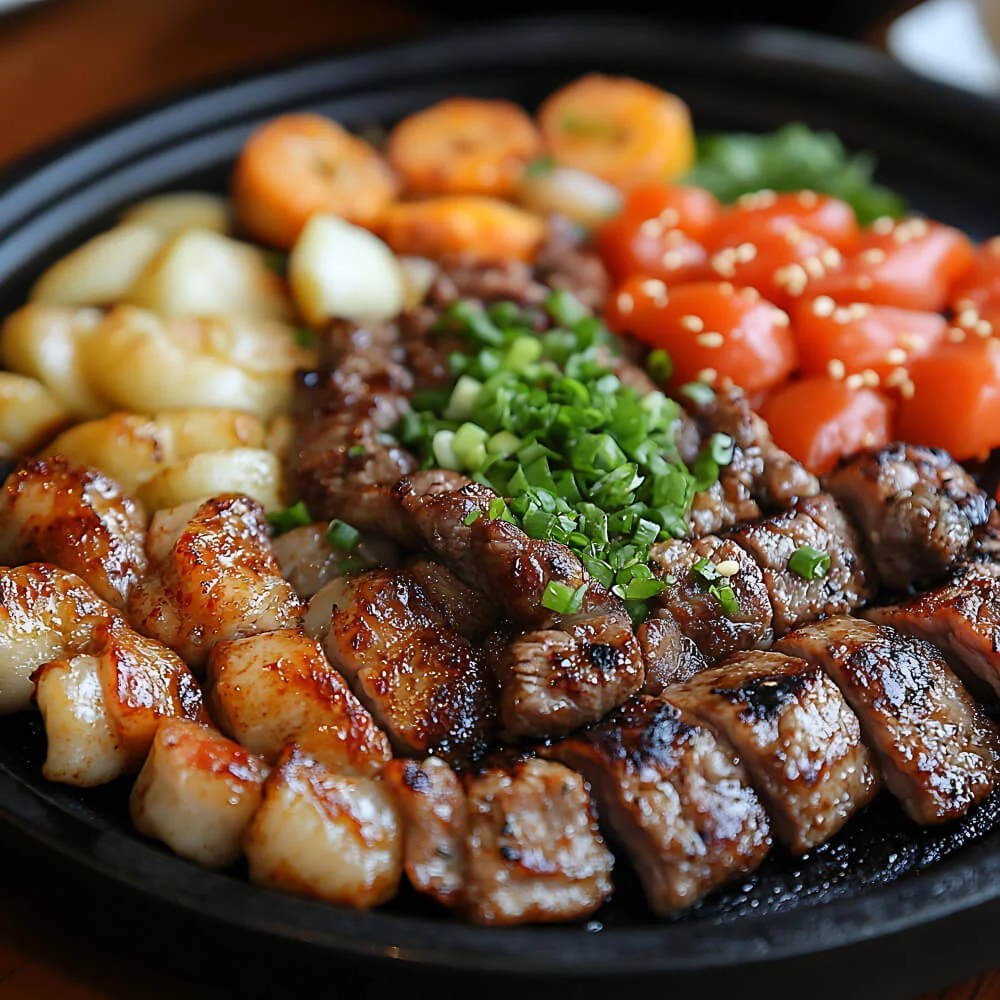
Simple Recipe for Korean Sweet Potato Snacks
Sweet potatoes are a beloved ingredient in Korean cuisine. A popular snack is goguma mattang (candied sweet potatoes):
- Peel and cube Korean sweet potatoes (purple-skinned with yellow flesh).
- Fry the sweet potato pieces in oil until crispy.
- Prepare a caramel coating by heating sugar and a small amount of water until golden.
- Toss the crispy sweet potatoes in the caramel, sprinkle with sesame seeds, and let cool.
Spicy Korean Snacks
How to Make Your Own Spicy Fried Rice Cakes (Tteokbokki)
Tteokbokki is one of Korea’s favorite spicy snacks. To make it at home:
- Ingredients: Korean rice cakes, gochujang (red chili paste), sugar, soy sauce, garlic, fish cakes, and green onions.
- Steps: Boil the rice cakes in water until soft, then simmer them in a sauce made with gochujang, sugar, and soy sauce. Add fish cakes and green onions for added texture.
- Serve warm for a satisfying, spicy, and chewy snack.
Kimchi Pancakes: A Savory Dish Perfect as a Snack
pancakes are crispy, spicy, and incredibly easy to make:
- Ingredients: Kimchi, all-purpose flour, water, egg, and a pinch of salt.
- Steps: Mix chopped kimchi with flour, water, and a beaten egg to form a batter.
- Pan-fry the batter in a skillet with oil until crispy and golden on both sides.
Korean Street Food Snacks
Making Your Own Gimbap (Korean Sushi Rolls): Stuffed with Pickled Radish, Egg, Spinach, and More
Gimbap is a popular Korean street food made with seasoned rice and a variety of fillings wrapped in seaweed.
Steps to Make Gimbap:
- Prepare seasoned rice by mixing cooked rice with sesame oil and salt.
- Lay out a sheet of seaweed and spread a thin layer of rice on it.
- Add fillings like pickled radish (danmuji), spinach, julienned carrots, fried egg strips, and cooked ground beef or tuna.
- Roll the gimbap tightly using a bamboo sushi mat and slice into bite-sized pieces.
Kimbap Rolls with Different Fillings
Gimbap can be customized with various fillings to suit your taste:
- Classic Gimbap: Filled with egg, pickled radish, and spinach.
- Tuna Gimbap: Features tuna mixed with mayonnaise and cucumber.
- Vegetarian Gimbap: Packed with colorful vegetables like carrots, zucchini, and mushrooms.
- Spicy Gimbap: Add gochujang-marinated beef or spicy kimchi for extra heat.
Korean Snacks for Kids
Making Sweet Rice Cakes or Choco Pies for Kids
Korean snacks for kids are often sweet, chewy, and fun to eat:
- Sweet Rice Cakes (Chapssaltteok): These soft, chewy rice cakes are filled with sweetened red bean paste or chocolate for a kid-friendly twist. Simply mix glutinous rice flour, water, and sugar, steam until tender, and add your favorite filling.
- Choco Pies: A homemade version of this popular snack can be made by sandwiching marshmallow fluff between two soft chocolate cakes and coating the entire treat with melted chocolate. Chill until the coating sets for a deliciously sweet treat.
Easy-to-Make Kimchi Snacks That Are Mild and Kid-Friendly
To make kimchi snacks mild for kids:
- Use fresh, young kimchi with less spice. Lightly rinse it to tone down the heat.
- Make kimchi pancakes (kimchi jeon) using smaller amounts of kimchi mixed with batter for a mild, savory snack.
- Add mild kimchi to fried rice, which balances the flavor while introducing kids to this classic ingredient.
Healthy Korean Snack Options
Roasted Sweet Potatoes or Yam Chips
Roasted sweet potatoes, or goguma, are a healthy and satisfying Korean snack:
- Bake whole sweet potatoes in the oven at 375°F until tender. The natural sweetness shines through, and they make a fiber-rich snack.
- For yam chips, slice sweet potatoes thinly, toss with a light coating of olive oil and a sprinkle of salt, and bake until crispy for a healthier alternative to fried chips.
Edamame with a Korean Twist (Seasoned with Gochugaru)
Edamame is a protein-packed, nutritious snack that can be given a Korean twist:
- Boil fresh or frozen edamame pods and drain.
- Toss with a mixture of sesame oil, a pinch of gochugaru (Korean red chili flakes), and salt.
- For a milder version, season with sesame oil, garlic powder, and a sprinkle of toasted sesame seeds.
Traditional Korean Snacks
How to Prepare Traditional Korean Snacks: Jjinppang (Steamed Bread) or Banchan (Side Dishes)
- Jjinppang (Steamed Bread): Soft and fluffy steamed buns filled with sweet red bean paste or savory ingredients. To make jjinppang:
- Prepare a yeast-based dough and let it rise.
- Stuff with red bean paste, shape into round buns, and steam for 15–20 minutes until soft and cooked through.
- Banchan (Side Dishes): Small dishes served alongside meals can also double as snacks. Popular options include seasoned spinach (sigeumchi namul), soy-marinated eggs, or pan-fried tofu with a light soy sauce drizzle.
How to Make Traditional Korean Fruit Jellies
Korean fruit jellies, or gwail jeonggwa, are lightly sweetened, chewy treats made with fresh fruits like apples, pears, or citrus.
- Simmer thin fruit slices in a sugar and water mixture with a hint of ginger for flavor.
- Reduce the liquid until the fruit pieces become glossy and slightly translucent.
- Chill the fruit slices or serve them as a chewy, candied snack.
Vegan and Gluten-Free Korean Snacks
Vegan-Friendly Korean Rice Cakes (Bokkeumbap)
Bokkeumbap refers to stir-fried rice dishes, but when prepared with Korean rice cakes (tteok), it becomes a hearty, chewy, and vegan-friendly snack.
- Ingredients: Korean rice cakes, gochujang (Korean chili paste), soy sauce, garlic, vegetables (like mushrooms, spinach, and carrots), and sesame oil.
- Steps:
- Soften rice cakes in warm water.
- Sauté garlic and vegetables in sesame oil.
- Stir in gochujang, soy sauce, and softened rice cakes. Cook until coated and heated through.
Gluten-Free Options Like Korean-Style Steamed Vegetables or Seaweed Wraps
- Korean-Style Steamed Vegetables (Namul): Lightly steam spinach, bean sprouts, or zucchini, and season with sesame oil, garlic, and a pinch of salt. This simple side snack is gluten-free and packed with nutrients.
- Seaweed Wraps (Gim Ssang): Use roasted seaweed sheets as a wrap filled with rice, sautéed vegetables, and tofu. This gluten-free snack is a lighter alternative to gimbap.
Korean Snack Dips and Sauces
Making Gochujang-Based Dips
Gochujang (Korean chili paste) is a key ingredient in Korean cuisine, and it makes a fantastic base for dips:
- Mix gochujang with sesame oil, honey (or a vegan sweetener), and a touch of soy sauce.
- Add garlic and a sprinkle of sesame seeds for extra flavor.
This dip pairs perfectly with vegetable sticks, seaweed snacks, or Korean pancakes.
Easy Soy Sauce-Based Dipping Sauces for Korean Dumplings or Pancakes
For a simple and delicious dipping sauce:
- Ingredients: Soy sauce, rice vinegar, sesame oil, chopped green onions, garlic, and chili flakes.
- Steps: Combine all ingredients in a small bowl and mix well.
Popular Ingredients for Korean Snacks
Key Ingredients in Korean Snacks: Gochujang, Sesame Oil, Dried Seaweed, Rice Flour, and Kimchi
- Gochujang: A fermented chili paste that adds spicy, savory, and slightly sweet flavors. Perfect for dips, sauces, and rice cakes.
- Sesame Oil: Adds a nutty aroma and flavor, commonly used in stir-fried and steamed snacks.
- Dried Seaweed (Gim): Roasted seaweed sheets make a crunchy, salty snack and are perfect for wraps.
- Rice Flour: A gluten-free flour used in making rice cakes, dumplings, and traditional desserts like tteok or songpyeon.
- Kimchi: Fermented vegetables, typically cabbage or radish, seasoned with chili paste, garlic, and ginger. It’s a key ingredient in pancakes, fried rice, and dips.
How to Incorporate These Ingredients Into Your Snacks
- Gochujang: Mix into sauces, marinades, or stir-fried dishes for heat and depth.
- Sesame Oil: Use to season steamed vegetables, rice cakes, or dumplings.
- Dried Seaweed: Enjoy as a snack or use to wrap rice, vegetables, and tofu.
- Rice Flour: Make chewy rice cakes or gluten-free pancakes.
- Kimchi: Add to fried rice, stir-fried noodles, or use as a spicy, tangy topping.
Storing and Serving Korean Snacks
Best Ways to Store Homemade Korean Snacks
Proper storage ensures your homemade Korean snacks stay fresh and delicious:
- Rice Cakes (Tteok): Store in an airtight container in the fridge for up to 2–3 days. To prevent hardening, sprinkle a little water and reheat by steaming or microwaving.
- Kimchi Snacks: Kimchi-based dishes like pancakes (kimchi jeon) should be stored in the refrigerator and consumed within 1–2 days for the best taste.
- Gimbap: Wrap gimbap rolls tightly in plastic wrap or foil to keep them fresh. Store in the fridge for up to 24 hours, but note that the rice may harden over time.
- Dry Snacks: Store crispy snacks like roasted seaweed (gim) or sweet potato chips in a sealed container at room temperature to maintain their crunch.
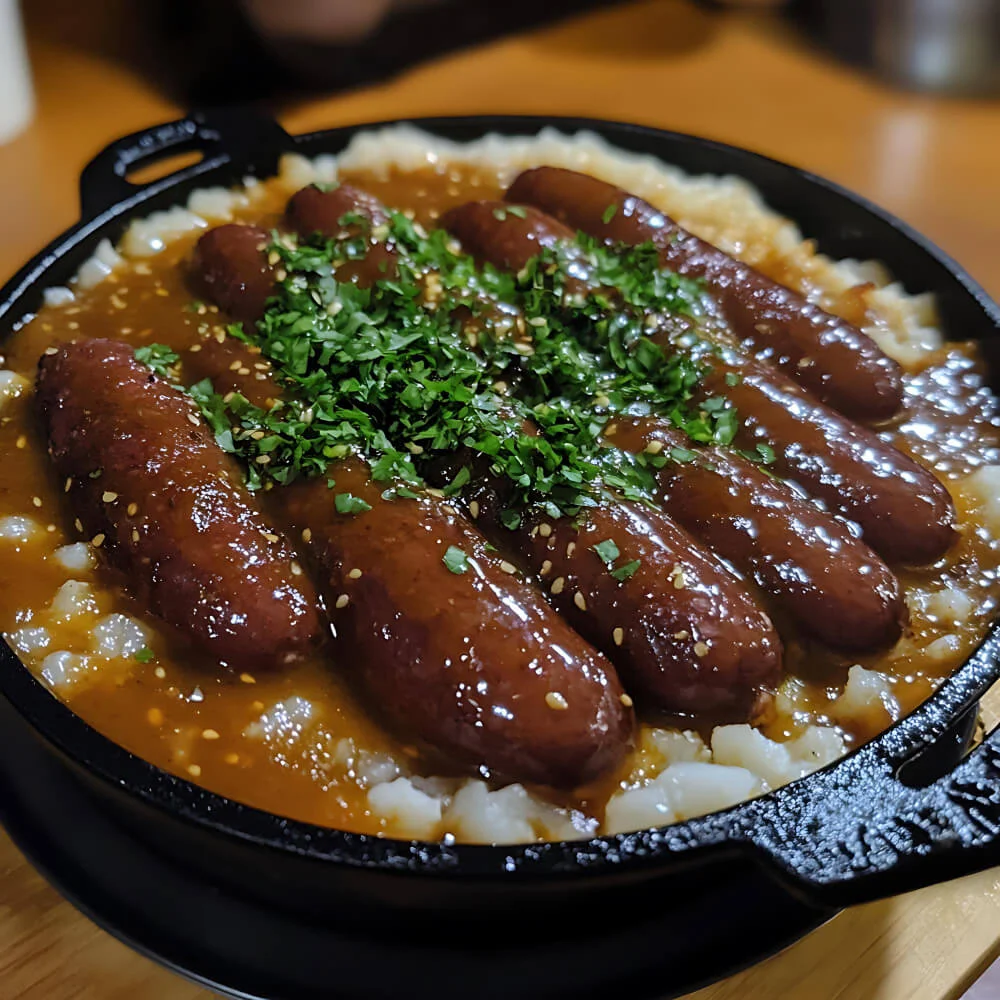
Tips on Serving Korean Snacks for Parties or Gatherings
Korean snacks are perfect for parties and gatherings due to their variety and shareable nature. Here’s how to serve them:
- Create a Snack Platter: Include a mix of sweet and savory options like gimbap rolls, kimchi pancakes, roasted peanuts, and seaweed snacks for variety.
- Use Small Portions: Serve bite-sized snacks such as tteokbokki or spring rolls on small plates or skewers for easy sharing.
- Add Dips and Sauces: Pair snacks with gochujang-based dips, soy sauce, or spicy mayo to elevate flavors.
- Decorative Presentation: Use traditional Korean plates or bamboo trays for a beautiful and authentic presentation.
Nutritional Information of Korean Snacks
Calories and Nutrient Breakdown for Popular Snacks Like Tteokbokki, Gimbap, and Kimchi
Understanding the nutritional content of popular Korean snacks can help you make mindful choices:
- Tteokbokki (Spicy Rice Cakes): A serving (1 cup) contains approximately 250–300 calories, with carbs as the primary macronutrient. Add vegetables or tofu for extra nutrients.
- Gimbap (Korean Sushi Rolls): One roll contains about 200–300 calories, depending on the fillings. Tuna or beef gimbap provides more protein, while vegetarian versions are lighter.
- Kimchi: This fermented side dish is low in calories (10–15 calories per 2 tablespoons) but packed with probiotics, fiber, and vitamins like A and C.
Healthy Snack Alternatives to Reduce Calories
For healthier options, consider these alternatives:
- Baked Instead of Fried: Replace fried snacks like potato chips with baked sweet potato chips or roasted seaweed.
- Low-Sodium Kimchi: Choose low-salt versions of kimchi to reduce sodium intake while still enjoying its tangy flavor.
- Vegetable Gimbap: Swap high-calorie meat fillings with fresh vegetables, mushrooms, and tofu for a nutrient-dense, low-calorie snack.
- Steamed Rice Cakes: Instead of frying, steam rice cakes and pair them with a light soy or sesame dipping sauce.
Frequently Asked Questions
How Spicy Are Korean Snacks Like Tteokbokki?
Tteokbokki (spicy rice cakes) is typically quite spicy due to the use of gochujang (Korean chili paste). However, the heat level can be adjusted to suit your preference. For a milder version, reduce the amount of gochujang and add a bit of sugar or honey to balance the spice. Some recipes also use soy sauce as a substitute for a gentler flavor.
Can I Make Korean Snacks Without Gochujang?
Yes! While gochujang is a staple ingredient in many Korean dishes, you can still enjoy Korean snacks without it. Substitute with:
- Soy Sauce: For savory snacks like dumplings or stir-fried dishes.
- Sesame Oil and Garlic: Adds depth to vegetable-based snacks.
- Sweet Chili Sauce: For a milder, sweet-and-spicy alternative.
What Are Some Popular Korean Snacks?
Some of the most popular Korean snacks include:
- Tteokbokki: Chewy rice cakes in a spicy gochujang sauce.
- Kimchi Pancakes (Kimchi Jeon): Crispy and savory pancakes made with kimchi.
- Hotteok: Sweet pancakes filled with brown sugar and nuts.
- Gimbap: Korean rice rolls with a variety of fillings.
- Honey Butter Chips: Sweet and savory potato chips that are a modern favorite.
What Snacks Do Korean Kids Like?
Korean kids enjoy a variety of fun and flavorful snacks, including:
- Choco Pies: Soft cakes filled with marshmallow and coated in chocolate.
- Sweet Rice Cakes: Chewy and lightly sweetened rice-based treats.
- Banana Milk: A popular flavored milk drink often paired with snacks.
- Gim (Roasted Seaweed): Light, crunchy sheets of seasoned seaweed that are nutritious and delicious.
What Do Koreans Cook at Home?
At home, Koreans often prepare simple and hearty snacks or meals, such as:
- Banchan (Side Dishes): Small portions of kimchi, pickled vegetables, or steamed spinach.
- Rice-Based Snacks: Tteokbokki (rice cakes) or fried rice (bokkeumbap).
- Street Food Favorites: Homemade hotteok, gimbap, or kimchi pancakes.
What Is the Korean Traditional Rice Puff Snack?
The traditional Korean rice puff snack is called Gangjeong. Made by puffing rice or grains, gangjeong is often coated with honey, syrup, or sesame seeds, giving it a crispy texture and sweet flavor. It’s a popular snack during Korean holidays like Lunar New Year and can be enjoyed as a light, crunchy treat.
Conclusion
Korean snacks have gained global popularity for their exciting mix of flavors, textures, and versatility. Whether it’s the spicy and savory kick of tteokbokki, the sweet warmth of hotteok, or the crisp crunch of kimchi chips, Korean snacks cater to every craving. They seamlessly blend traditional ingredients like gochujang, sesame oil, and rice flour with modern twists, creating unique snacks enjoyed by all ages.
Recreating Korean snacks at home is not only fun but also a rewarding way to explore new flavors. With easy-to-follow recipes like gimbap, kimchi pancakes, and sweet rice cakes, you can enjoy authentic Korean treats straight from your kitchen.
Korean snacks are a delightful mix of savory, sweet, and spicy flavors, offering something for every taste bud. From the chewy Tteokbokki (spicy rice cakes) to the crispy satisfaction of Kimchi Pancakes or roasted seaweed sheets, Korean cuisine brings bold, unique snacks to your table. Whether you’re enjoying popular options like gimbap or exploring healthier alternatives like seasoned edamame, there’s no shortage of variety. Looking for more exciting food ideas? Check out recipes like Fruit Snacks and Asian Snacks for inspiration on making globally loved treats at home.
Viral Tuna Salad: 5 Bold Reasons Matthew McConaughey’s Recipe Wins
Healthy Homemade Chicken Mortadella
Chicken Mortadella changed my deli game forever. I used to stare at processed meat…
The BEST Taco Pasta
When I’m short on time and need to get a satisfying dinner on…
Classic German Kartoffelpuffer Recipe (Authentic, Crispy & Easy to Make)
Easy Butter Pecan Cookies Recipe
There’s something undeniably comforting about the scent of buttery, nutty cookies wafting from…
Perfect Strawberry Cheesecake Recipe
If there’s one dessert that’s guaranteed to silence a lively room, it’s this…


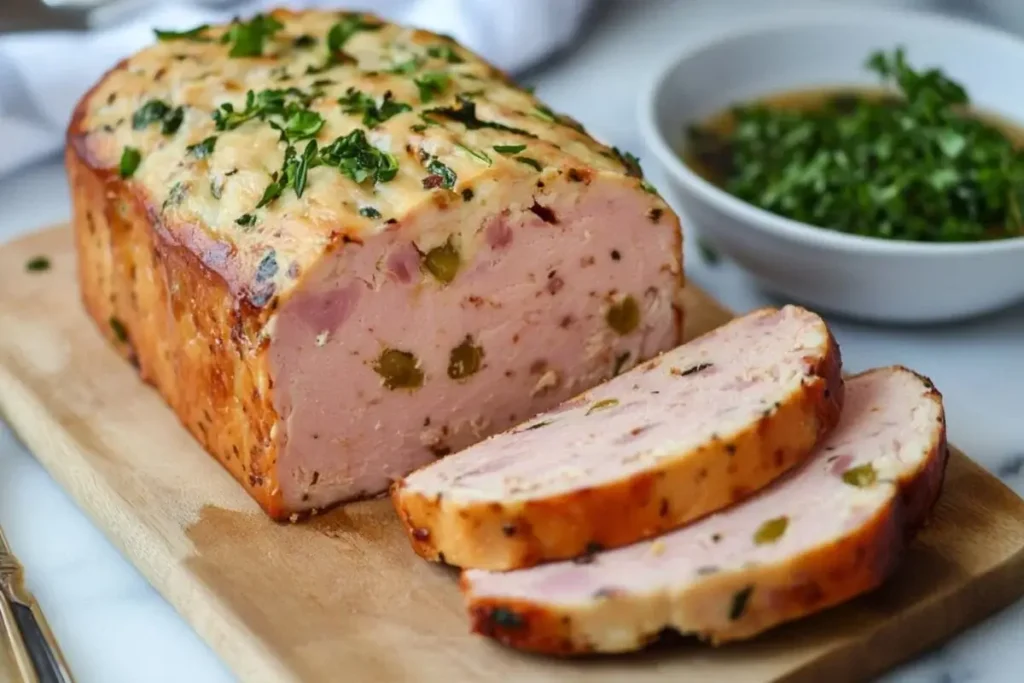

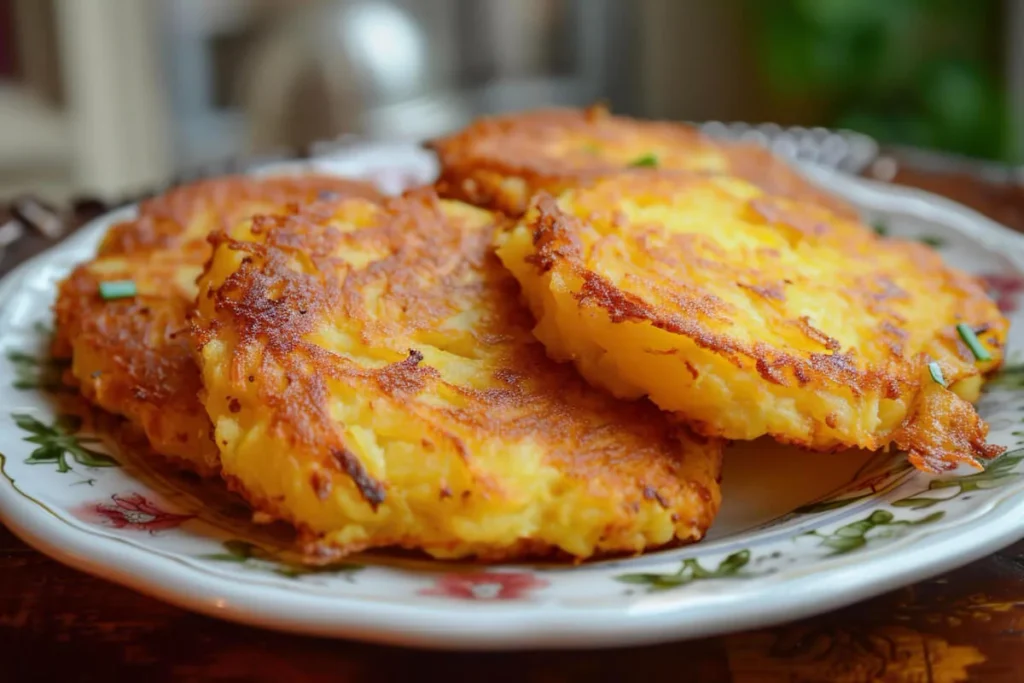


3 thoughts on “Korean Snack”